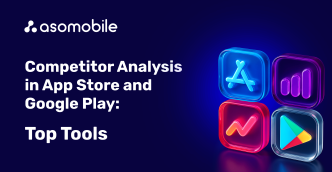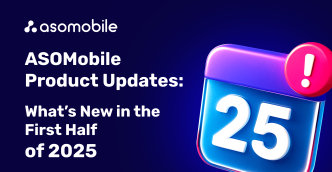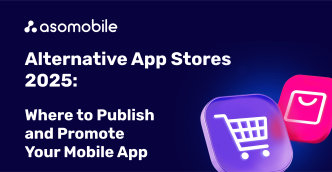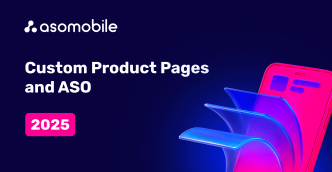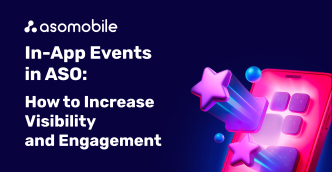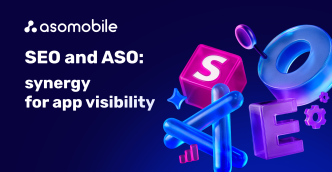SEO and ASO: Synergy for App Visibility
Choosing between SEO and ASO is like standing in front of the fridge, wondering: take the cheese or the bread? But what about the sandwich?
Today’s successful digital marketing demands an “and,” not an “or” approach. SEO and ASO work better together: one operates in the browser, the other in the app store — but both aim to bring users to our app. In 2025, SEO and ASO are no longer two separate worlds but complementary channels that work together to build a substantial user acquisition and retention funnel.
– Why is it important to talk about this now?
– What are the risks of using only one channel?
Let’s put everything in order, like in a fridge.
SEO + ASO: Why “and” not “or”
Let’s start from the beginning and define the leading players in this article.
SEO (Search Engine Optimization) — optimizing websites for search engines. The goal is to rank high in Google and other search engines so users click, read, and convert.
ASO (App Store Optimization) — optimizing apps for App Store and Google Play. The goal is to be found by keywords, installed and rated highly.
They may seem like two different worlds, but they belong to the same galaxy of digital marketing. And like in space, these two worlds are drawn to each other, stabilizing one another without crashing.
Let’s walk through the main points of this alliance and form our view on it.
SEO vs or & ASO
You could compare SEO and ASO to the wings of a soaring bird, but let’s skip the poetry and get to the point. Here it is.
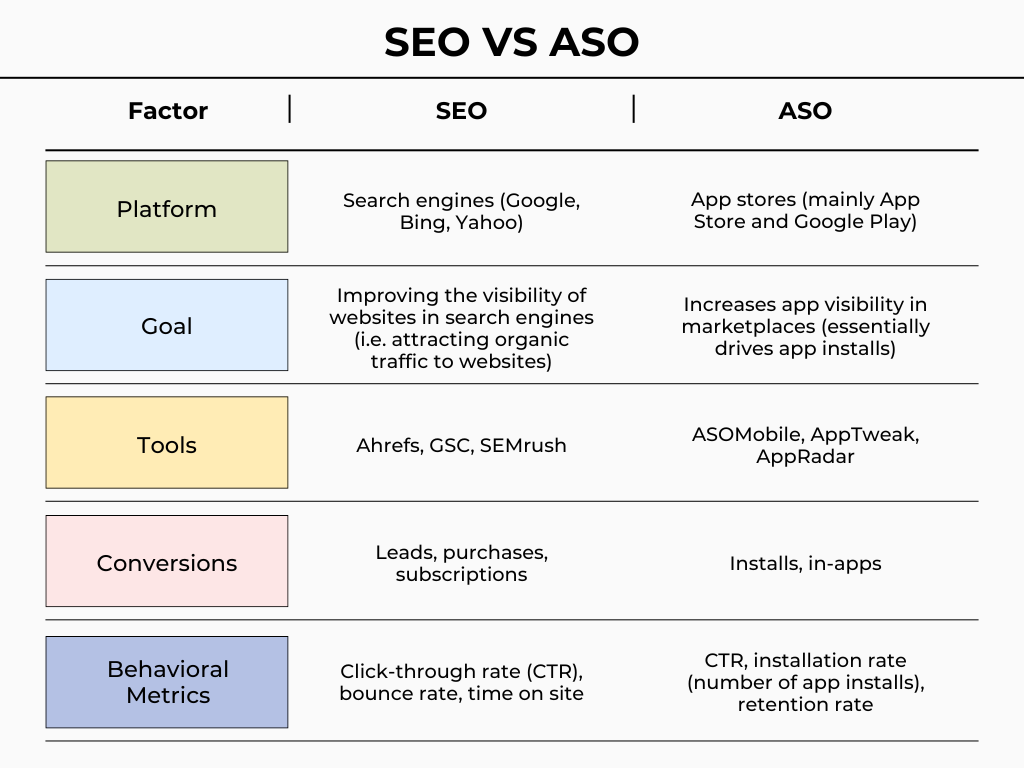
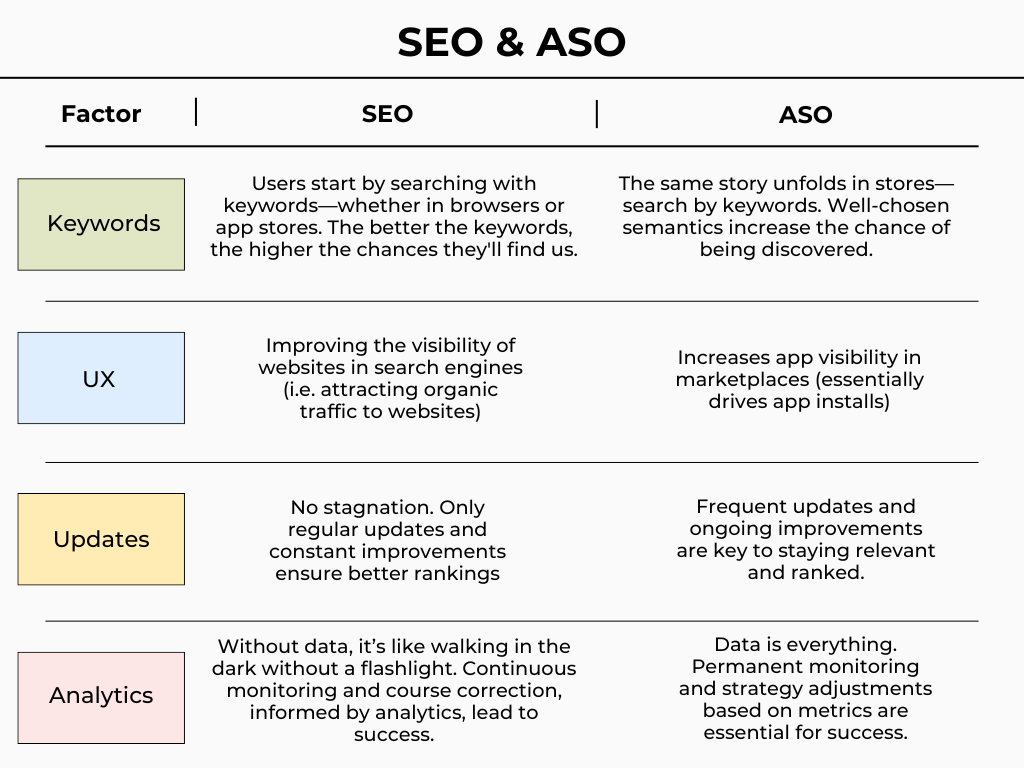
After the comparison, it’s worth exploring how SEO supports ASO and vice versa.
How SEO supports ASO:
- Blog = inbound traffic
A strong website means strong content. The ideal scenario: run a blog — share fresh news, expert opinions, influencer insights. Be engaging and helpful because great blog content boosts the app. A link in every post leads straight to installs. - Brand = recognition in the App Store
Apple fans love brands. iPhone users Google the brand → search it in the App Store → recognize → download - a clear example of SEO fueling the funnel. - And Google Play? Backlinks = app visibility.
For Google, external backlinks to the app positively impact visibility. ASO benefits from SEO backlinks.
How ASO supports SEO:
- Reviews + rating = brand trust
A high app rating boosts overall brand credibility, which in turn reflects positively on SEO. Users unhappy with the app are less likely to click on your site. - Campaign alignment
Ad campaigns (App Store, Google Ads) and content strategies must work in sync. The app and website aren’t rivals — they’re two legs of the same body moving forward.
Tools and Metrics
SEO
Tools: Ahrefs, Google Search Console, SEMrush.
Metrics: traffic, CTR, rankings, bounce rate, conversions.
A bit more detail:
Ahrefs — great for backlink analysis, keyword research, and competitor tracking. Understand where competitors generate traffic, their top-performing pages, and their SEO strategies.
Google Search Console (GSC) — Google's official tool for webmasters. Shows search queries, positions, CTR, and detects indexing issues.
SEMrush — an all-in-one platform: site audit, keyword research, ranking tracking, competitor analysis, content, and PPC strategy.
Metrics explained:
- Traffic — number of organic visitors to the site. More traffic = more reach.
- CTR (Click-Through Rate) — how many users clicked after seeing the site in search results. A low CTR indicates a need for improved titles and descriptions.
- Search rankings — positions in SERPs by keywords. The core metric of SEO.
- Bounce rate — % of users who left the page without interaction. High bounce = irrelevant or weak page.
- Conversions — any target action (purchase, form, etc). The main goal.
ASO
Tools: ASOMobile, AppFollow, Apple Search Ads.
Metrics: installs, conversion from views, rating, retention, and keyword rank.
More details:
ASOMobile — an easy-to-use tool for keyword ranking, A/B testing, reviews, and competitor analysis. Works for both the App Store and Google Play.
AppFollow helps track reviews, ratings, rankings, and metadata, and simplifies support work. Great for large teams.
Apple Search Ads — not just ads, but also research. See which keywords drive installs and use that data for organic ASO.
Metrics explained:
- Installs — total app downloads (organic + paid).
- Conversion from views (CVR) — % of users who installed after viewing the app page. Influenced by icons, screenshots, titles, and descriptions.
- Rating — average user score. Impacts trust and ranking.
- Retention — how many users keep using the app after 1/7/30 days? Higher retention = better ASO and product health.
- Keyword rank — the app’s position for a given keyword. Core ASO metric.
Best Practices SEO and ASO 2025
Artificial Intelligence
AI is booming — from generating descriptions to predicting user behavior.
Find high-conversion keywords and long-tail queries, analyze competitor strategies, and more.
For SEO: content generation, topical clustering, tone of voice, audits, and performance analysis.
AI is your first ally in the battle for top charts.
Localization
The translation is not localization. Accurate localization respects culture and search behavior in every country. Anything else is just poetry.
Seasonality
Prepare SEO content and refresh app visuals and descriptions in advance to accommodate holiday periods and algorithm updates.
A/B Testing
Test titles, screenshots, and descriptions as much as possible. The most clickable version wins.
What else can you do?
- Thorough keyword analysis — always. For both ASO and SEO.
- Creative assets matter — test visuals, experiment, get inspired, repeat.
- Reviews and ratings — respond, especially to negative ones. Implement good suggestions. Encourage happy users to rate.
- Paid UA — cooperation between ASO and UA teams = synergy.
- Use Apple Search Ads in the App Store.
- For SEO: high-quality content, originality, meta tags, backlinks, and technical performance (a fast site wins).
Unified Strategy
One channel is not enough to get app installs. SEO and ASO are not rivals — they are parts of the same funnel. The goal isn’t to argue over importance but to work together. Users move across channels, and the smoother the path, the higher the conversions and loyalty.
Here’s what a cross-channel framework looks like:
- SEO grabs attention
The user searches on Google and lands on a blog, landing page, or product page. If SEO is strong, they engage and discover the brand. - They move to app stores.
The blog or site should have a clear "Download app" button. If interested, the user clicks and is redirected to the App Store or Google Play. - ASO welcomes and convinces
Now ASO takes over: icon, screenshots, video, title, and description. The app page must answer the question “Should I install this?” with a confident yes. - After installation comes retention
Installs are only half the battle. The real goal is to keep the user. Enter UX, push notifications, onboarding, and valuable features. - Loyalty and return — back to SEO
A happy user might subscribe to a newsletter, return for blog updates, or recommend your brand, and the cycle begins again.
Final Thought
Those who don’t separate SEO and ASO into “yours” and “mine” win today. Success comes to teams that build seamless user journeys — from search to installation to loyalty. SEO and ASO are not cheese or bread. They’re the sandwich you share with friends.
 Українська
Українська  Русский
Русский  Español
Español 